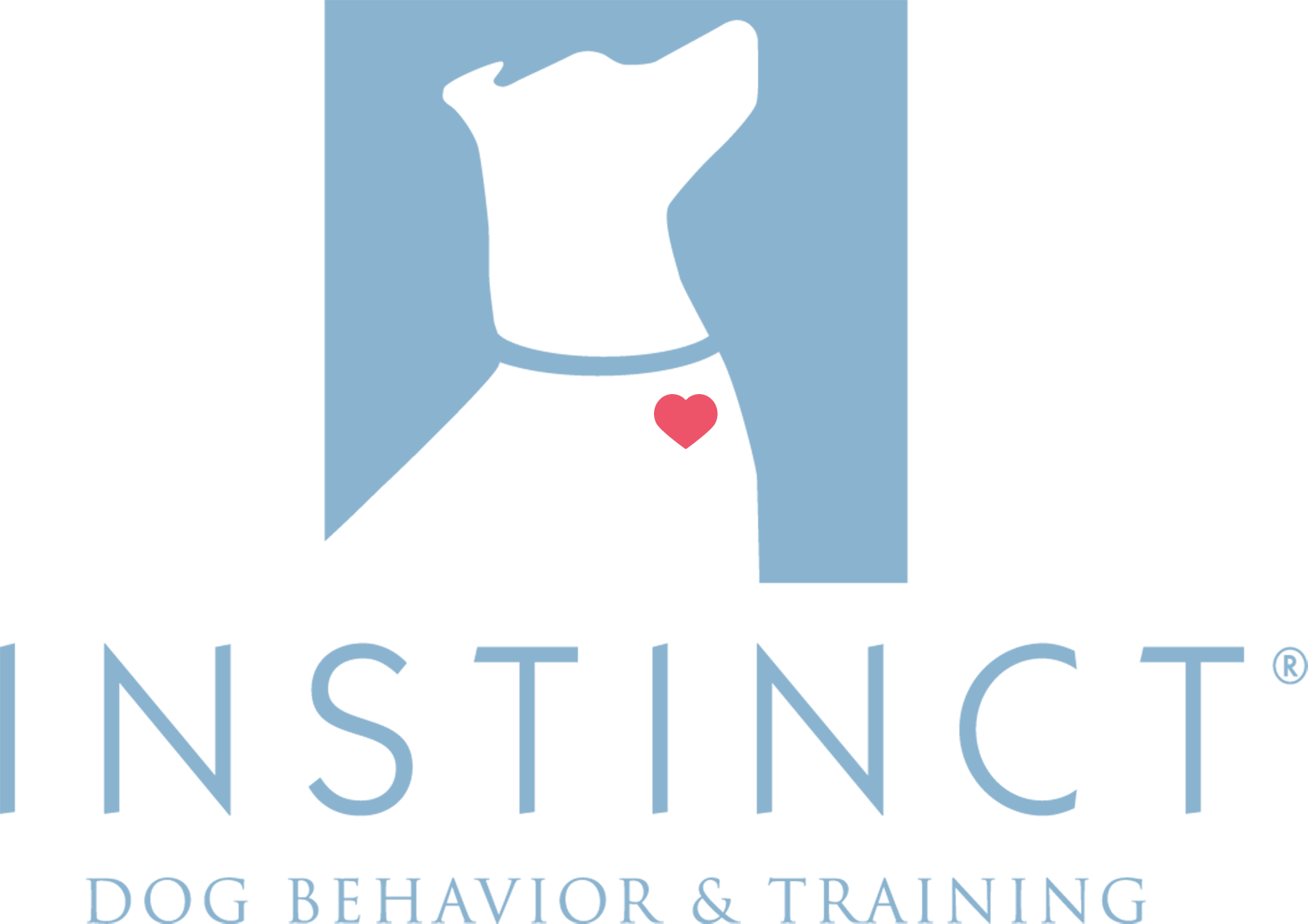The Essential Info You Need to Get (& Keep) Your Pup’s Potty Training on Track!
Potty training a puppy takes effort and consistency, but it is generally a fairly straightforward process if you follow some simple rules and guidelines.
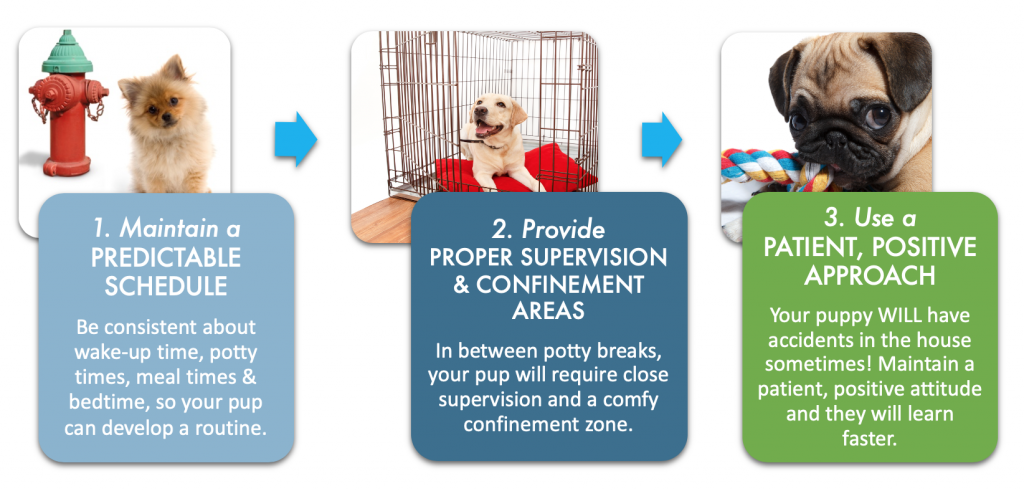
KEY #1: MAINTAIN A PREDICTABLE SCHEDULE
 Maintaining a consistent, predictable schedule helps your puppy get into the routine of potty training and makes it easier for them to build good habits. In this section, we’ll review how to:
Maintaining a consistent, predictable schedule helps your puppy get into the routine of potty training and makes it easier for them to build good habits. In this section, we’ll review how to:
- 1.a) Follow the Potty Training Flow Chart
- 1.b) Set up a schedule that works for your pup’s age
- 1.c) Keep a potty training log that ensures your whole family is keeping your pup on a consistent schedule
- 1.d) Conduct potty breaks in a way that ensures your pup learns to ‘go’ quickly when you take them outside
1.a) POTTY TRAINING FLOW CHART:
Your pup’s potty training schedule should repeat this cycle of events throughout the day:

Note that during potty training, your puppy should only ever be in one of three situations:
- in their crate or pen resting
- on a supervised potty break
- enjoying some supervised free time, which can include any combo of a walk, yard time, indoor play time, and indoor tether/settle time.
1.b) FREQUENCY OF POTTY BREAKS BY AGE
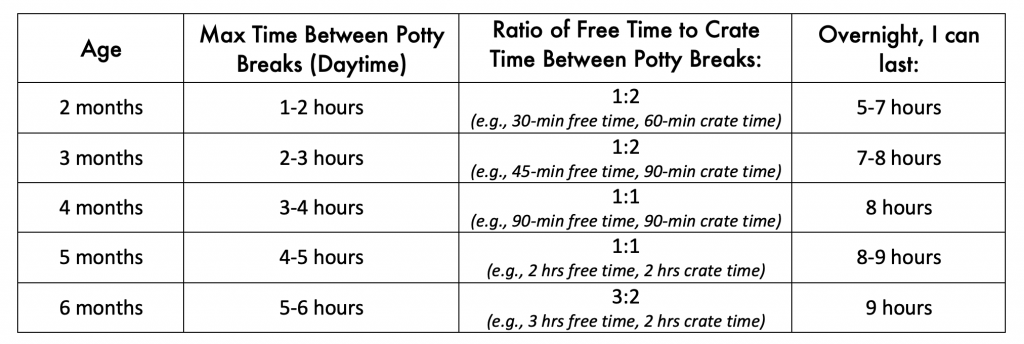
*Meals can be fed at the end of a free time period, just before a crate time period.
**In addition to their regularly scheduled potty breaks, remember that puppies often need to pee or poop:
- Immediately after running around and playing
- Soon after taking a drink or eating a meal
- Immediately after waking up from a nap
1.c) DAILY PUPPY SCHEDULE LOG
Use the two charts above (Potty-Training Flow Chart & Frequency of Potty Breaks by Age chart) to create potty training schedule for your puppy. Then, use the daily puppy schedule log below to track your pup’s progress!
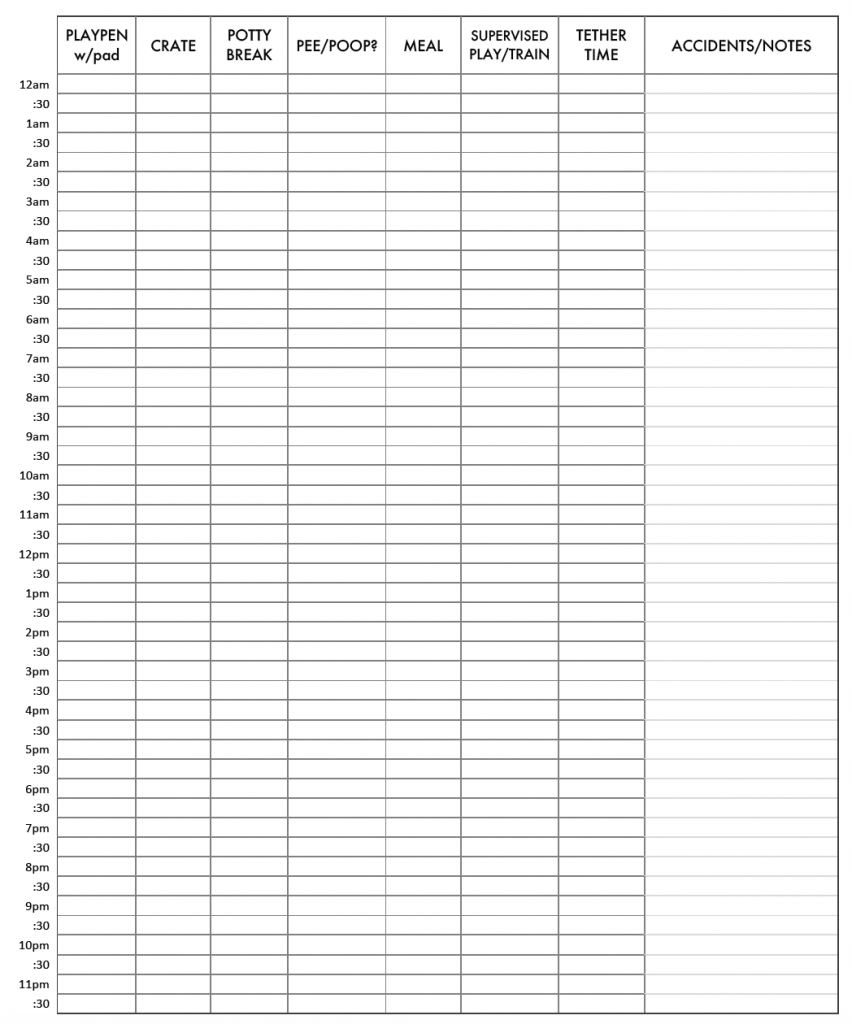
1.d) HOW-TO: TIPS FOR SUCCESSFUL POTTY BREAKS
There are a few simple tricks you can use to avoid accidents and get your puppy to go quickly and consistently each time you take them out for a potty break:
- Don’t Dilly Dally. Take your puppy outside immediately after they come out of their crate or confinement area.
- Keep your puppy on a leash, even if you’re just going out in your backyard. This ensures you can keep a close eye on your puppy, AND it makes it easier for you to praise & reward them promptly when they do pee or poop.
- Stick to a small area. If you walk from place to place, your pup will constantly be distracted by new sights & smells, and it will take them longer to go potty. Wait until after they pee and poop, then praise and reward them with the chance to explore.
- Get ‘em moving. If your pup is on “poop strike”, try doing a quick little run-around with them in a small area; the activity can stimulate them to go.
KEY #2: PROVIDE PROPER SUPERVISION & CONFINEMENT AREAS
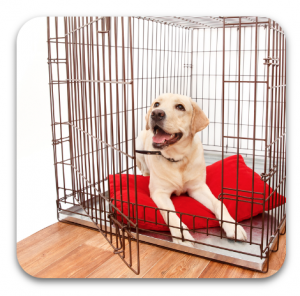 Providing proper supervision during free time AND setting up a designated confinement/rest area can mean the difference between a successful potty training program and an unsuccessful one. This section will provide you with simple guidelines to:
Providing proper supervision during free time AND setting up a designated confinement/rest area can mean the difference between a successful potty training program and an unsuccessful one. This section will provide you with simple guidelines to:
- 2.a) Structure free time in a way reduces the likelihood of accidents
- 2.b) Set up both short-term & medium-term confinement areas to reduce accidents, build bladder control, AND ensure your pup is getting the rest they need
2.a) HOW-TO: TIPS FOR SUCCESSFUL FREE TIME
Remember: based on the Potty Training Flow Chart, your pup is ALWAYS in one of three situations during potty training: in their crate/confinement area, on a potty break, or enjoying some free time. We have TWO simple rules to follow to ensure free time doesn’t become ‘free-for-all’ time:
- Free time = supervised time; this means:
-
- Your pup needs to be in the same room as you
- You need to have two eyes on your puppy at all times when they are out for free time
- Your pup should go in their crate or pen if you need to step outside even for just a minute
- Free time = active play + tether time/settle time;
- For many puppies, the ideal ratio of active play to settle time during free time is about 1:1
- For example, if your 3-month-old puppy currently does about 45 minutes of free time before going into her crate for a nap, that free time might be split into 20 minutes of active play & training, then 20 minutes of quietly chewing on a bone next to you while on a tether
- Providing a mix of both active play AND settle time ensures that:
- your pup can actually hold it until the next potty break (remember, physical activity can stimulate them to need to go pee or poop)
- your pup doesn’t inadvertently learn that free time = non-stop party time
- your pup doesn’t become overstimulated, leading to increased mouthiness/nipping (if you are struggling with puppy nipping & biting, check out our guide to reducing puppy biting).
2.b) HOW-TO: TIPS FOR SETTING UP CONFINEMENT AREAS
There are two types of confinement areas we use during potty training: a) a crate, and b) a pen or gated, puppy-proofed area. The crate and the pen serve different purposes. Most puppy owners find it easiest to have both options available, while other owners find they need only one or the other, based on their schedule and their individual puppy. Below are guidelines for when & how to use a crate vs. a pen during potty training:
- The Crate.
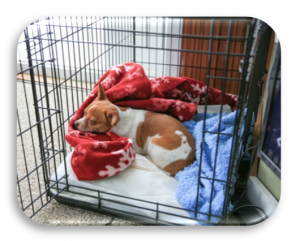
-
- What: a plastic or wire kennel designed to keep a dog or puppy safely & securely confined and out of trouble when an owner is not present.
- Why: a crate can be helpful during potty training because, if sized correctly, it can encourage a pup to learn to hold their bladder at times when an owner may not be able to directly supervise the pup. This cuts down on potty accidents, thus speeding up potty training. As an added benefit, getting your pup comfortable in a crate means they won’t be stressed if they ever go to board at a vet’s office or kennel.
- How: a crate should be large enough for a puppy to stand, turn around, and lie down comfortably, but not so large that the pup can comfortably create both a “potty area” and a “sleeping area” inside the crate. The crate can be made comfy by putting a fleece blanket or crate pad inside, along with a couple of toys and bones that are safe for the pup to have without direct supervision. Some pups find it easier to settle if a lightweight sheet is draped over the front of the crate. Just be sure to leave the backside uncovered to allow plenty of airflow.
- When: a crate should be used for short term confinement only, never for longer than your pup is able to hold their bladder, and ideally, never more than 3-4 hours at a time (even if they can hold it longer than that).
When it Comes to the Crate, Don’t Overdo It. A crate is a really helpful training tool but be careful not to overuse it. Crates are small, confined spaces, and while they are perfectly okay to use for short periods of time throughout the day, we don’t want our pups to have to spend too much time in them.
2. The Pen or Gated Area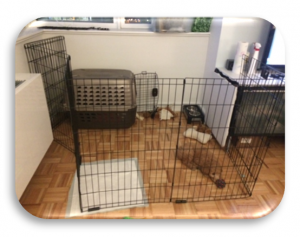
-
- What: think of this as similar to a play pen for (human) babies. It is a safe, secure area where the pup can move around and play with toys when an owner is unable to directly supervise or is not present. But this pen has an indoor potty area in the form of a wee wee pad or litter box.
- Why: a pen keeps your puppy safe & secure, just like a crate, when you are unable to supervise them. But, unlike a crate, a pen also provides your pup with access to a designated indoor spot to go potty
- How: a pen or gated area should include a few things: the dog’s (open) crate with a comfy bed or blanket inside; a wee wee pad in a tray (to discourage chewing/tearing) or litter box; a bowl of fresh water, and several safe toys and bones. The pen/gate should be securely fixed in place and high enough that your pup can’t scale over it.
- When: a pen can be used for medium-term confinement, when your puppy will need to wait longer than they are currently able to hold it, to receive a potty break. This ensures they are not soiling their crate/themselves, and they are still practicing going in an “approved” potty spot.
- Examples: if your 2-month-old pup needs to go out for a potty break every 90 minutes, but you need to be out of the house for 2.5 hours, you can leave your puppy in their pen with access to a wee wee pad, instead of in their crate. Same goes for overnight: if your pup can only last about 6 hours overnight, but you need a solid 8 hrs to feel functional, have your pup sleep in a pen with a wee wee pad overnight until they get a little older.
Your Pen or Gated Area Can Replace Your Crate. As your pup ages, you can often ditch the crate entirely, and use the pen/gated area as your pup’s primary confinement area when they are left alone (until they are old enough to be trusted not to chew up your pillows and get into things that might harm them!). When you notice that your puppy is no longer making use of the wee wee pads during pen time, that’s a good cue that you can remove the pads altogether and swap out closed crate time for pen time.
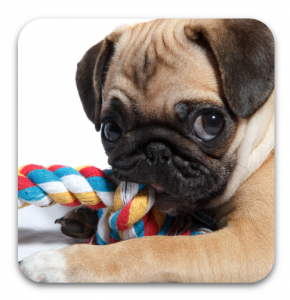
KEY #3: USE A PATIENT, POSITIVE APPROACH
This is the shortest section in our potty training basics guide, but it is one of the most important! Why? Because it is a reminder that:
- 3.a) Your puppy is still a baby
- 3.b) Potty training is a process
3.a) Your Puppy is Still a Baby.
It is sometimes easy to forget just how young our pups are when we bring them home. But they really are just babies, still developing control over their bodily functions while they also attempt to learn how to navigate a new environment, new people, and whole new set of silly human rules. Stay positive. Reward and celebrate with your pup when they do the right thing. Stay calm and avoid scolding if they have an accident in the house – you want to remain a safe, trusted place for your pup to turn as they grow up.
3.b) Potty Training is a Process.
It takes time, and your progress will not be a straight line. Your puppy WILL have accidents in the house. Sometimes, it will be 100% your fault because you waited too long to take them out, you missed a clear signal that they were about to go, or your attention got diverted by life and your pup went without you noticing. Other times, you won’t know exactly why. Maybe your pup had a bigger drink than normal. Maybe they were just feeling a little bit yucky or extra sleepy, and they forgot themselves for a moment.
No matter the reason, just remember, this is normal! So long as you are doing your best to stick to the schedule, and so long as you are seeing a positive trend, you and your pull WILL be okay! Have patience, and look for progress, not perfection :).
One last reminder: there is additional help available!
The information in this guidebook is standardized advice that works for the majority of puppies. If you are following all of the guidelines enclosed here but you are still struggling, don’t worry! Some pups take a little longer to mature and develop bladder control. Some pups are nervous outside and thus are more likely to want to eliminate inside the home. And some pups are just plain tricky to potty train. If you are feeling frustrated, your primary care veterinarian and/or a professional trainer can provide you with support beyond what is outlined here, with guidance that is customized especially to your puppy and their individual needs.
Happy Training!
